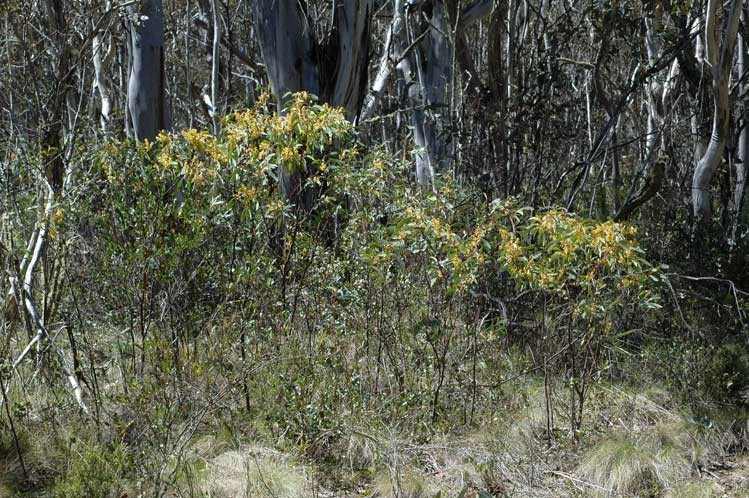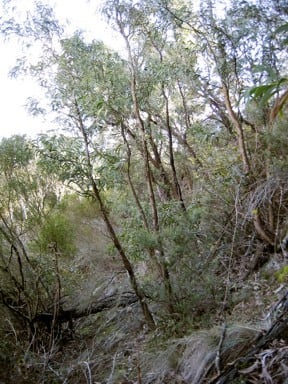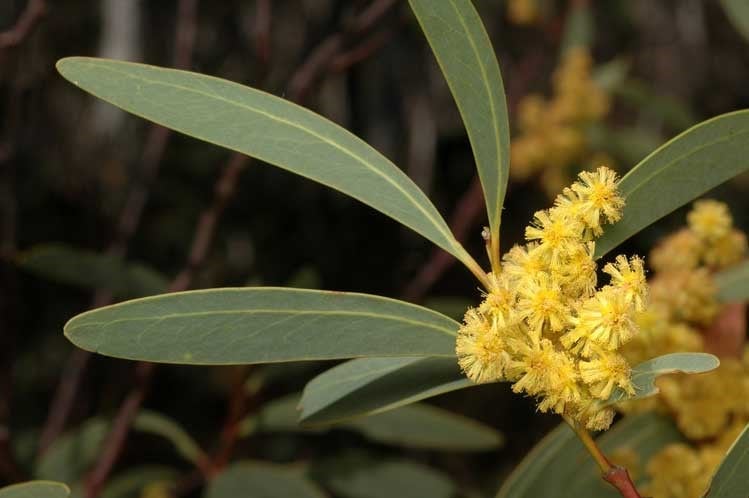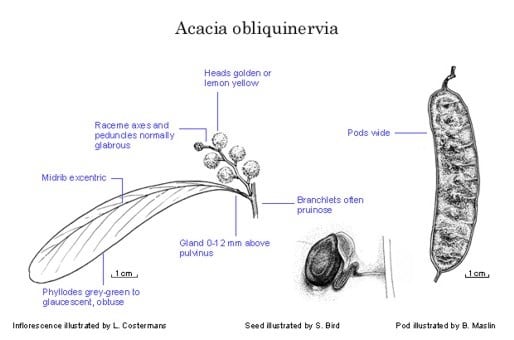Acacia obliquinervia Tindale
WATTLE
Acacias of Australia
Common Name
Mountain Hickory Wattle
Family
Fabaceae
Distribution
Occurs from Taloobie, 40 km N of Rylestone, N.S.W., S through A.C.T. to near Healesville, Vic., with a western outlier in the Grampians.
Description
Shrub or tree 1–15 m high. Branchlets commonly pruinose, glabrous. Phyllodes obovate to narrowly oblanceolate, sometimes narrowly elliptic, 5–17 cm long, 15–50 mm wide, narrowed and often recurved near base, obtuse, grey-green to glaucescent, glabrous, with prominent midrib situated towards the adaxial margin, penninerved; gland 0–12 mm above pulvinus. Inflorescences racemose, sometimes paniculate; raceme axes flexuose, mostly 2–10 cm long, glabrous; peduncles 1.5–5 mm long, stout, normally glabrous; heads globular, 20–35-flowered, bright golden or lemon yellow; buds sometimes obloid. Flowers 5-merous; sepals united for up to 4/5 their length. Pods stipitate, slightly raised over seeds along midline, 4–15 cm long, 11–20 (–25) mm wide, chartaceous to thinly coriaceous, slightly pruinose, glabrous. Seeds oblique, 5–6 mm long, oblong-elliptic to ovate, dull to slightly shiny, black; funicle thickly filiform, dark red-brown to black (dry), arillate.
Habitat
Common in montane forests and woodlands between 500 m and 1700 m alt.
Specimens
N.S.W.: c. 27 km NE of Rules Point on Fiery Ridge, T. & J.Whaite 2892 (PERTH). A.C.T.: Mt Franklin, 27 Nov. 1949, E.Gauba (MEL, PERTH). Vic.: Victoria Ra., Grampians, A.C.Beauglehole 9870 (MEL); Golden Gully Trail, East Gippsland, A.C.Beauglehole 34184 (MEL, NSW, PERTH).
Notes
Formerly confused with A. falciformis which is distinguished by its creamy yellow flower-heads, normally golden-puberulous peduncles and raceme axes, and phyllodes with a fine oblique nerve from the gland to the midrib. Short phyllode forms may resemble A. caerulescens or A. penninervis, both of which also possess an oblique nerve from the gland to the midrib, and occasionally A. sporadica which is a root-suckering shrub with non-pruinose branchlets, phyllodes with midrib more obviously excentric, peduncles stouter and often shorter, and seeds transverse in the pods. Sometimes superficially resembling A. pycnantha which is distinguished by its more numerous 40–80-flowered heads, narrower pods 5–7 mm wide, and green phyllodes with a ±central midrib.
L.Pedley, Austrobaileya 1: 267 (1978), regarded Acacia penninervis var. glauca R.T.Baker as conspecific with A. falciformis.
FOA Reference
Data derived from Flora of Australia Volumes 11A (2001), 11B (2001) and 12 (1998), products of ABRS, ©Commonwealth of Australia
Author
Minor edits by B.R.Maslin & J.Rogers
B.R.Maslin
This identification key and fact sheets are available as a mobile application:
URL: https://apps.lucidcentral.org/wattle/
© Copyright 2018. All rights reserved.

















